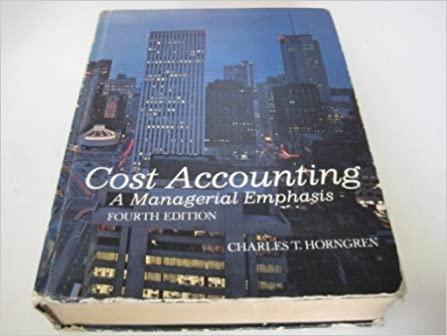Responsibility Accounting and Control of Costs The Sharp Company develops, manufactures, and markets several product lines of
Question:
Responsibility Accounting and Control of Costs ‘The Sharp Company develops, manufactures, and markets several product lines of low-cost consumer goods.
Top management of the company is attempting to evaluate the present method and a new method of charging the different production departments for the services they receive from one of the engineering departments, which is called Manufacturing Engineering Services (MES).
The function of MES, which consists of about thirty engineers and ten draftsmen, is to reduce the costs of producing the different products of the company by improving machine and manufacturing process design, while maintaining the required level of quality. The MES manager reports to the engineering supervisor, who reports to the vice-president, manufacturing. The MES manager may increase or decrease the number of engineers under him.
He is evaluated on the basis of several variables, one of which is the annual incremental savings to the company brought about by his department in ex-
_ cess of the costs of operating his department. These costs consist of actual salaries, a share of corporate overhead, the cost of office supplies used by his department, and a cost of capital charge. An individual engineer is evaluated on the basis of the ratio of the annual savings he effects to his annual salary.
The salary range of an engineer is defined by his personnel classification; there are four classifications, and promotion from one classification to another depends on the approval of a panel that includes both production and engineering personnel Production department managers report to a production supervisor, who reports to the vice-president, manufacturing. The production department for each product line is treated as a profit center, and engineering services are provided at a cost, according to the following plan. When a production department manager and an engineer agree on a possible project to improve production efficiency, they sign a contract that specifies the scope of the project, the estimated savings to be realized, the probability of success, and the number of engineering man-hours of each personnel classification required.
The charge to the particular production department is determined by the product of the number of man-hours required times the “classification rate”
for each personnel classification. This rate depends on the average salary for the classification involved and a share of the engineering department’s other costs. An engineer is expected to spend at least 85 percent of his time on specific, contracted projects; the remainder may be used for preliminary investigations of potential cost-saving projects or self-improving study. A recent survey showed that production managers have a high degree of confidence in the MES engineers.
A new plan has been proposed to top management, in which no charge will be made to production departments for engineering services. In all other respects the new system will be identical to the present. Production managers will continue to request engineering services as under the present plan. Proponents of the new plan say that under it, production managers will take a greater advantage of existing engineering talent. Regardless of how engineering services are accounted for, the company is committed to the idea of production departments being profit centers.
Evaluate the strong and weak points of the present and proposed plans. Will the company tend to hire the optimal quantity of engineering talent? Will this engineering talent be used as effectively as possible?
Step by Step Answer:






